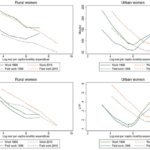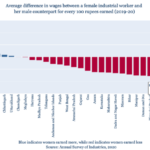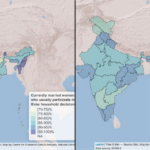Are Indian women quitting paid work because of increased sexual violence?
Recorded labour force participation of Indian women, never very high, logged a dramatic decline between 2004-5 and 2011-12 and has continued to decline thereafter, albeit at a lower rate. The bulk of the decline has been in the labour force participation rate (LFPR) of rural women; urban women, whose LFPR was always lower than that for rural women, did not register a decline.
Data from the National Sample Survey’s (NSS) quinquennial employment-unemployment surveys (EUS) and the periodic labour force survey (PLFS) reveal that rural female LFPRs declined by 25 percentage points (from roughly 50 to 25 percent), whereas urban female LFPRs continued their historically low levels, and declined slightly (from roughly 22 to 20 percent) (Figure 1)

Figure 1, based on my ongoing work with Jitendra Singh, shows the trends in female labour force participation rates between 1999-2000 and 2017-18. In addition to the total LFPR (measuring women engaged in economic work both inside and outside their homes), we also see proportions of employed women working outside their home (employed outside household premises, labelled as “…outside house…”). While total rural LFPR is higher than urban, urban women are much more likely to work outside the home than rural. Figure 1 also shows that the LFPRs of women working outside their household premises have not registered a decline.
Fewer Women Workers: why?
What do these numbers reflect? Are there fewer women in the labour force because they would rather not take up paid employment, as they would be at greater risk of sexual violence? Indeed, Indian women have to face high levels of violence both inside and outside the home. A ranking accords India the dubious distinction of “the most dangerous country to be a woman”.
Or is it the case that women’s inclination to participate in paid work has not diminished, but that work is more irregular or fractured, and therefore, women workers don’t get recorded as workers? Additionally, is it also true that while women’s educational levels have increased, job availability, commensurate with their education and skills, has not? There is compelling evidence onthese counts, but the spotlight typically shines on the sexual violence/social norms story, both in academic literature as well as media commentaries (such as here and here).
Rising Sexual Violence and Women’s Work
Violence against women is a major public health problem globally. The consequences of violence are debilitating as they affect multiple dimensions of women’s lives and are extremely serious. One set of consequences relate to women’s ability to work.
As the WHO points out “women may suffer isolation, inability to work, loss of wages, lack of participation in regular activities and limited ability to care for themselves and their children” (WHO, 2017)
To what extent can the decline in Indian women’s LFPRs be explained by a rise in violence against them?
Recent studies (such as Siddique (2018) or Chakraborty et al (2018)) find that the perceptions of violence deter women from working outside the home, in the sense that either women are less likely to work in regions with greater violence against women, or that increased reports of sexual violence reduce the probability of urban women working outside the home. Borker (2018) finds that fear of sexual violence influences college choice by women in Delhi: compared to men, they are more likely to choose a lower quality college if the route of travel is safer, as well as spend an amount as high as double the average college tuition to travel on a safer route. This evidence is entirely plausible: women are less likely to go to regions with high rates of public crimes against women; yet these results do not shed light on the persistence of low average labour force participation of Indian women. Also, the sexual violence and stigma narrative does not account for the decline which is driven by a decline in the LFPRs of rural women, and especially of rural Adivasi women.
Let us examine trends in female LFPRs along with trends in crimes against women (Figure 2).

Panel A of Figure 2 shows that the period of the sharpest decline in rural female LFPRs (between 2004 and 2012) was a period during or before which incidence of rape and assaults did not change, but during which, instances of cruelty by husband and relatives increased. Between 2013 and 2017, reports ofcruelty declined but rural female LFPR continued to decline.
Panel B plots the LFPR outside the home and along with the same crime figures (the levels appear higher in Panel B because of scale change: the vertical axis goes from 0 to 16, whereas in Panel A it goes up to 40). We see that female employment outside the home in rural areas is flat between 2004 and 2017 (the period when the total rural female LFPR registered a decline), and in urban areas, it registers an upward trend. This increase is accompanied by a rise in assault cases (between 2011 and 2013) and rise in cruelty cases between 2004 and 2013. Rape cases increase from 2011 onwards, with slight fluctuations.
Figure 2 does not support the expected correlation between crimes against women and their ability to work outside the home. Instead, it suggests that there is very little connection between the two, if any.
However, it raises several questions that need greater attention and emphasis, which are discussed briefly below.
Importance of Measurement
One, Figure 2 suggests that the decline in LFPRs is really driven by women involved in economic work in home enterprises, not those in paid employment outside their homes. This lends a great deal of credence to studies arguing that the decline in women’s work is not an actual decline, but a move from paid to unpaid work (Mondal et al, 2018).
Two, this also highlights the need to measure women’s work correctly. The National Data Innovation Centre (NDIC) conclusively demonstrates the importance of correct measurement. Their study (Deshmukh et al, 2019) shows how work participation rates are sensitive to survey design. They argue that standard labour force status questions, where respondents are asked to identify primary and secondary activities of women, resulted in women being listed as “homemakers”. However, when respondents were asked about who participated in wage work, non-wage subsistence work and family business, the same women were more likely to be included as workers. They point out that this omission is particularly large for work on family farms and in caring for livestock, i.e., about 96 percent of women’s omitted activities are in these two areas. Thus, they make a case in favour of counting work, not workers.
My research with Naila Kabeer, based on a large primary survey conducted in West Bengal, shows how even small changes to the NSS questionnaire can make big differences to the estimates of labour force participation by better capturing the unpaid economic work that women routinely do on family farms, businesses or enterprises.
A Demand-side Story
Three, we need to pay attention to the lack of demand for labour in the occupations and activities in which women are concentrated. There is important work that shows that what we note as a decline (which is equated to withdrawal of women from the labour force in a supply-side mindset) is actually a manifestation of thechanging nature of work availability, especially for rural and less educatedwomen. This body of work questions the “decline” narrative (Desai (2017);Desai et al (2018),Chatterjee et al (2015)). This work shows that the proportion of economicallyactive women has not declined, but the number of days they work has, whichshows up as a decline in the labour force participation rates.In India over the last three decades, there has been a massive decline inagricultural jobs, and this has not necessarily been accompanied by an increasein manufacturing jobs, and/or other non-agricultural wage employment. There has been movement outof agriculture into informal and casual jobs, where the work is sporadic, andoften less than 30 days at a stretch. The new modern sector opportunities, especially in high value-added service sectors, mostlyaccruing to men.
Since the decline in LFPRs has been driven by rural women, the latest evidence from Afridi et at (2020) offers valuable insights. They show that mechanisation has led to significantly greater decline in women’s than men’s labour in Indian farms. They find that reduced demand for labour in weeding, a task that requires precision and a task which was more often undertaken by women, explains a large part of a decline in women’s labour. The study shows when specialisation of work is sex-specific, technological change can have gendered impacts.
Gender-based employer discrimination
Fourth, the entire attention on social norms is from the supply side. However, social norms, instead of affecting women’s propensity to work in paid employment, could shape employers’ discrimination, and lower their demand for women workers. Das et al (2019) investigate if there are cultural factors that bias employers against hiring women. Based on a unique survey of over 600 firms in three large cities of Madhya Pradesh, they find that the likelihood of the firm having at least one woman employee is strongly influenced by firm characteristics such as location and size, after controlling for which employer attitudes are not a significant determinant of whether the firm hires a woman or not. The implication of their findings is that culture might be slow to change, but policies aimed at increasing female employment need not wait for cultural change.
Crime numbers: greater crime or higher reporting?
Finally, what do the crime numbers represent? Worldwide, most of the violence against women is domestic violence (DV) or intimate partner violence (IPV) and is typically underreported. India is no exception to this global pattern. The only way to identify an incidence of violence is when it gets reported. A rise in reported violence, especially assault and cruelty complaints, could reflect either increased incidence or greater reporting or both.
It is virtually impossible to disentangle these two components; given a rise in Indian women’s education levels, it is highly likely that greater reporting is also responsible for the increased numbers. To the extent this is true, this reflects greater agency.
The official focus on safety of women outside their homes is completely blind and oblivious to the dangers to their safety and well-being inside their own homes. This mindset leads to highly controversial proposals that are likely to make it more difficult for women to join paid work.
What does the international evidence indicate?
India is certainly not in a minority internationally as far as DV, IPV or any other form of violence against women are concerned. Gender-based violence (GBV) is serious and ubiquitous. Yet, recorded female LFPRs are significantly lower in India compared to other countries.
Since a link between GBV and female LFPRs is made strongly in the Indian context, what is the evidence on this link elsewhere in the world?
In ongoing work with Jitendra Singh, we examined data for over 100 countries for various years between 1990 and 2017 to check for correlations between the ratio of female to male (F/M) LFPRs (using data from the International Labour Organisation) and indicators of violence against women (using data from the United Nations Statistical Division).
The correlation coefficient between F/M LFPR and assault is 0.2 (low and positive); rape is 0.24 (low and positive); sexual violence is 0.29 (low and positive) and IPV is -0.15 (low and negative). Figure 3 plots the scatterplots of F/M LFPRs along with a fitted line.

These are simple correlations and as we know too well, correlation does not imply causation. But even the correlations do not provide prima facie evidence that the ratio of female to LFPRs is strongly negatively correlated with a rise in violence against women.
In conclusion, gender-based violence and violence against women are extremely serious public health issues that need to be addressed with the urgency they deserve. The decline in women’s paid work in India is also equally serious, as it denies women the opportunities they deserve and a life of equality, dignity and independence. As long as women are not in the paid labour force, earning just rewards for their skills and talents, the Indian economy is robbed of the enormous productive potential of half its population. While both issues are very grave, the connection between the two is tenuous, at best.
The puzzle of why Indian women’s labour force participation rate is declining despite increasing education and lower fertility, the two preconditions to rising women’s LFPR, has many more pieces. The violence piece appears to fit, but as we see above, it actually does not. We need to join many more pieces, especially those of demand-side constraints, the gendered division of household chores and employer discrimination, to solve this puzzle.
If you wish to republish this article or use an extract or chart, please read CEDA’s republishing guidelines.







